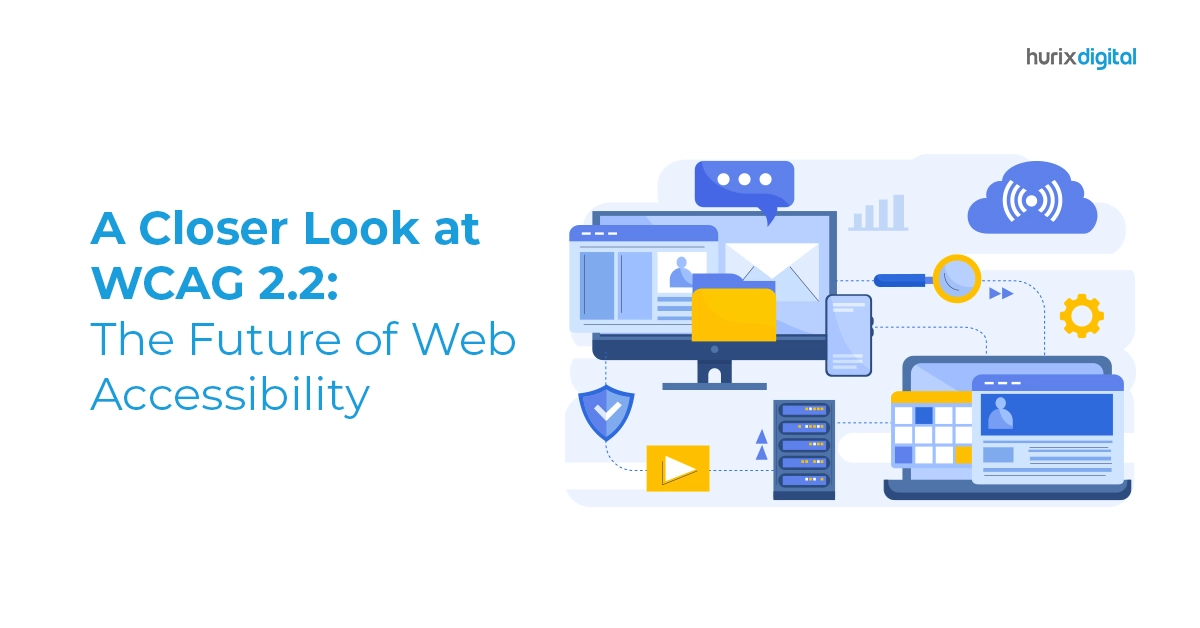Deepa Mani
December 4, 2023
A Closer Look at WCAG 2.2: The Future of Web Accessibility
Summary
This blog has introduced you to the latest updates in WCAG 2.2. It has also explained the importance of WCAG 2.2 and how it will make the internet more accessible for everyone.
The WCAG 2.2 success criteria build upon the previous versions of the guidelines, WCAG 2.0 and 2.1. One of the major updates in WCAG 2.2 is the addition of 9 new success criteria. We are very excited to share with you the latest updates on the Web Content Accessibility Guidelines (WCAG) 2.2. WCAG 2.2, set to launch in 2023, is here to make the internet more user-friendly for everyone.
In this blog, let’s understand what’s new in WCAG 2.2, why it is important, and how it will make the internet better for all of us.
Table of Contents:
- WCAG – A Quick Review
- What’s New in WCAG 2.2?
- Dropped Success Criteria
- WCAG Latest Version
- Conclusion
WCAG – A Quick Review
The Web Content Accessibility Guidelines (WCAG) provide guidelines and standards to make websites and applications easier to use for everyone. Before we move into the exciting new features of WCAG 2.2, let’s briefly revisit the previous versions:- WCAG 1.0 (1999): The first version laid the foundation for web accessibility, providing basic guidelines. It provides some basic guidelines to web developers to make their websites more accessible to people with disabilities.
- WCAG 2.0 (2008): This major update introduced the concept of four core principles: Perceivable, Operable, Understandable, and Robust (POUR). It is also classified under A, AA, and AAA conformance levels, (A, AA, AAA) to show how well a website followed these rules, with Level AAA being the highest.
- WCAG 2.1 (2018): This update expanded on 2.0 by adding new success criteria to address emerging technologies and better cater to people with disabilities. This update made WCAG cover guidelines and standards from various platforms for the changing digital world.
What’s New in WCAG 2.2?
WCAG 2.2 is set to build upon the foundation laid by its predecessors. WCAG 2.2 aims to make the web more user-friendly and inclusive for everyone by enhancing web accessibility. Here are some key highlights:1. Guideline 2.4 Navigable
- Focus Not Obscured (Minimum) (AA): Ensure when an item gets keyboard focus, it is at least partially visible.
- Focus Not Obscured (Enhanced) (AAA): Ensure when an item gets keyboard focus, it is fully visible.
- Focus Appearance (AAA): Use a focus indicator of sufficient size and contrast.
2. Guideline 2.5 Input Modalities
- Dragging Movements (AA): Use a focus indicator of sufficient size and contrast.
- Target Size (Minimum) (AA): Ensure targets meet a minimum size or have sufficient spacing around them.
3. Guideline 3.2 Predictable
- Consistent Help (A): Put help in the same place when it is on multiple pages.
- Guideline 3.3 Input Assistance
- Redundant Entry (A): Don’t ask for the same information twice in the same session.
- Accessible Authentication (Minimum) (AA): Don’t make people solve, recall, or transcribe something to log in.
- Accessible Authentication (Enhanced) (AAA): Don’t make people recognize objects or user-supplied images and media to log in.
Dropped Success Criteria
In the interest of relevance and practicality, WCAG 2.2 has retired some success criteria from previous versions. These success criteria are either considered outdated or incorporated into other success criteria to improve the WCAG guidelines.- Parsing is obsolete and removed from WCAG 2.2.
WCAG Latest Version
The Web Content Accessibility Guidelines (WCAG) are the industry standard for creating websites that are accessible to those with impairments. Building on WCAG 2.0, the most recent version, WCAG 2.1, adds new success criteria to address a wider range of accessibility problems. These include suggestions for improving online content accessibility for persons with cognitive and learning impairments as well as improvements for mobile accessibility.- Future of Websites: Accessibility is fundamentally linked to the future of websites. Websites that promote accessibility will prosper as the internet develops.
- Accessibility Solutions: To ensure website accessibility, organizations need to employ a variety of solutions.
- ADA Website Compliance: The Americans with Disabilities Act (ADA) requires websites to be accessible to individuals with disabilities. ADA website compliance is not just a legal requirement; it’s a moral imperative.
- Accessibility Website Checker: Accessibility website checkers are valuable tools in the quest for website accessibility. These automated accessibility website checkers scan websites for compliance with WCAG guidelines and flag accessibility issues. While they are a great starting point, it’s important to remember that they may not meet all accessibility barriers. Manual testing and user feedback, along with automated testing are very important to improve website accessibility.
Conclusion
WCAG 2.2 is going to be the future reference guide for web accessibility. WCAG 2.2 acknowledges the changing online world and strives to make accessibility better. As we eagerly await its official release in 2023, here are some key takeaways: Web accessibility is not just a checklist; it’s a commitment to inclusivity. Embrace the principles of WCAG to make the web a welcoming place for everyone.- Stay Updated: As technology evolves, so does web accessibility. Keep yourself informed about the WCAG latest version guidelines and updates, such as WCAG 2.2, to ensure your digital content remains accessible.
- Test and Iterate: Accessibility testing should be an integral part of web development. Test your websites and applications regularly with a variety of assistive technologies to identify and address potential issues.
- Collaboration is Key: Building accessible websites requires inputs from designers, developers, content creators, and users. Engage with all the stakeholders and seek feedback to improve accessibility continually.









